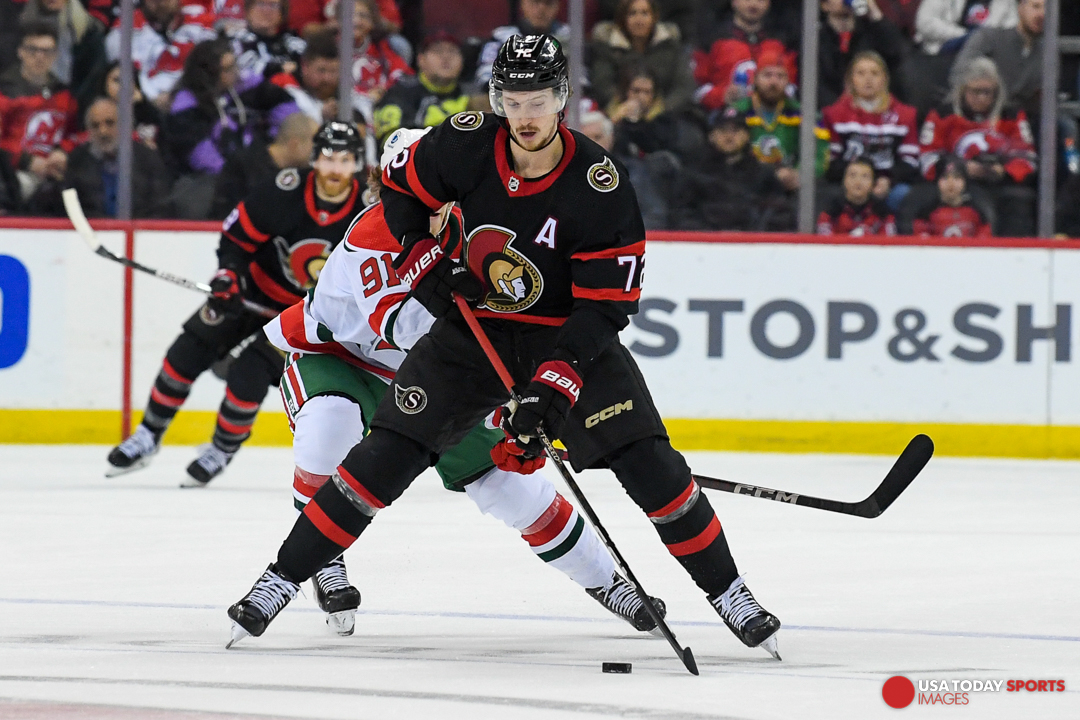Here is statistical analysis on Ottawa Senators defender Thomas Chabot and whether or not he is among the elite.
Are we talking about a defensive defenceman or a defensive forward? No, pure and simple, we want a great defender. One who plays defence, and best all-around contributes to his team getting Ws. Here we investigate how and why Thomas Chabot is one of the top defenders in the game. Yes, we may encounter the likes of Cale Makar, who makes everything he does look as sweet as cherry pie. But what we want is more than that we want the ability to control the game. We want their efforts to accumulate to be a positive net result and ultimately be better overall than their other defencemen counterparts.
The Numbers Behind How Can We Consider Thomas Chabot a Top Defender
To prove our hypothesis, of whether Thomas Chabot is an elite defender we must analyze some statistical metrics. First and foremost, is the metric defensive point shares (DPS). This stat includes many different variables in its calculation. It looks at such things as time on ice but as a ratio to total time on ice by all skaters. Furthermore, the metric uses a lot of shot or goal proportion statistics, for the team versus the league. We shall direct you to please see hockey-reference for the specific calculation. There are marginal statistics used, which are basically comparing team statistics with league-wide ones. The calculation includes one worth noting, that is more specific to the player. A player’s plus-minus is directly proportional to the team’s plus-minus for that same position, which is inversely proportional to a team time on ice for a position. Outside of that plus minus adjustment metric, the rest of the calculations are very much based on the team compared against league-wide. Therefore, if your team is successful, and you are on the ice a lot, it will show in DPS.
The Results of the Stat for a Defender’s DPS
All that explanation kind of makes sense if you look at the best career DPS tallies. We focused on the period since the calculation changed to include the time on ice statistic, which only started being recorded in 1998-99. Hence, most all of the defencemen on the list played a lot of minutes on relatively successful clubs. Players like Drew Doughty, Ryan Suter, or Mark Giordano find themselves immersed in the leaderboards.
We decided to choose a supplementary metric to DPS to compare Thomas Chabot’s abilities as an elite defender. That metric is how he ranks league-wide in expected goals by a defenceman. This will be a way to combine how a defenceman performs defensively, with their abilities to contribute to the offensive aspects of a team’s overall performance.
Chabot’s Best Season
Let us start by studying Chabot’s 2018-19 campaign. It cannot be overstated enough how dominant of a season he compiled for himself. Playing alongside mostly Dylan Demelo or Cody Ceci, Chabot had one of the best statistical seasons for an Ottawa Senator defender. Obviously, it is only the eighth-best season for total points, but that’s because someone named Erik Karlsson has six of those spots. That season, Chabot had 55 points in only 70 contests. Additionally, he had an offensive point share (OPS) of 4.8, an outstanding mark for anyone, but particularly defencemen. He had a DPS of 2.7 for a total PS of 7.5. He put up these numbers while logging 24:17 time on ice per game. Besides that season, Chabot has not had that level of PS value, but what he has been doing is increasing his DPS. It has been 3.6 and 3.1, respectively, in the last two seasons.
How Does Chabot Really Compare League Wide
For 2022-23, the leaders around the league were Hampus Lindholm of the Boston Bruins at 7.2, Devon Toews of the Colorado Avalanche at 7.0, and Minnesota Wild Jared Spurgeon at 6.6. Chabot’s rating was 103rd league-wide, and behind teammates Erik Brannstrom (3.1) and Jake Sanderson (3.4). In contrast, it is (always) a very close race for the crown of this statistic. For instance, a rating of 5.0, would land you 19th, where Charlie McAvoy finds himself. If we want to baseline Chabot with say, Cale Makar, Makar was 40th at 4.5.
Now if we want to compare a bit of offence, let’s look at expected goals, as determined by our friends at Moneypuck.com. We consider the condition of a minimum of 1000 minutes of time on ice throughout the regular season. Here are some more of the usual suspects, 1st sits Roman Josi at 17.7 and 2nd Stanley Cup finalist, Brandon Montour. His teammate, Aaron Ekblad sits in third. They had ratings of 16.9 and 16.2, respectively. Cale Makar sits in 8th with 12.3. Next, let’s move on to the top Senators, where at 11th we find Jakob Chychrun and 20th, our subject, Thomas Chabot. Chychrun posted an 11.5 in this category, while Chabot achieved a 9.3.
Focusing On Chabot’s Strengths in 2022-23
Chabot ranked 31st in the NHL with 41 points amongst defencemen in 2022-23. He played the 39th most in total ice time, despite only suiting up for 68 games. His share of possible ice time was eighth at 41.2%. Now, we had to dig deep, but there is one statistic that truly highlights Chabot’s greatness and Chychrun’s as well. That statistic is Relative Expected Goals %. Chabot lead the league at 14.9% and Chychrun was sixth at 12.7%. This is an important stat because it is the difference between the expected goal % for when you are on the ice versus when you are on the bench. Thus, there is something to say, that Chabot may not be as efficient as some other defenders in capitalizing on opportunities. Conversely, more often than not, and impressively we might add since he is on the ice so much, he generates offence. Therefore, we may conclude that Chabot is an elite defender.
What Does It All Mean for Chabot and His Defence Mates in 2023-24
In the upcoming 2023-24, Thomas Chabot the elite defender is going to have a lot of insulation around him. Considering the names of Artem Zub, Chychrun, and Sanderson, and a pile of hot competition for the third pairing, the Sens blueline has depth. The one aspect of the top four that is so exciting is their versatility. This will allow Chabot to play with less pressure than he has been accustomed to throughout his time in the nation’s capital. It is possible, playing a little less, will optimize the performance of his play. The one downside to the competition for Chabot individually, will be the lessening of top power play privileges. However, from a team standpoint, that is beneficial. Plus for Chabot, his seniority should be good enough to earn him the first chance. So, if he is rejuvenated just enough, maybe this is the season he excels, and leads the Senators to springtime hockey glory.
Main Photo: Dennis Schneidler-USA TODAY Sports






